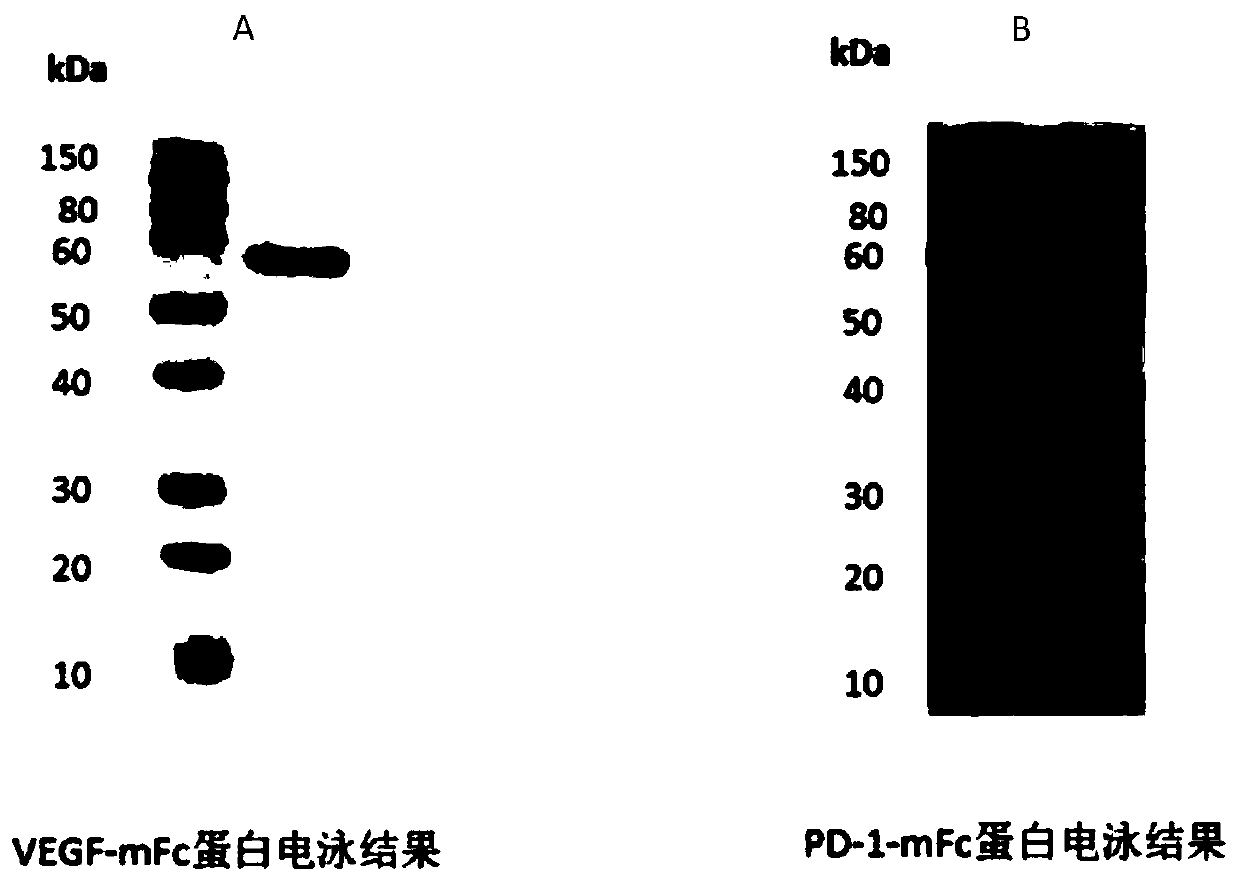Anti-VEGF and anti-PD1 bispecific antibody with novel structure
A bispecific antibody and a new structure technology, applied in the field of molecular immunology, can solve the problems of not being able to adapt to complex diseases and single antibody effect, achieve the best experimental results and inhibit tumor growth
- Summary
- Abstract
- Description
- Claims
- Application Information
AI Technical Summary
Problems solved by technology
Method used
Image
Examples
Embodiment 1
[0040] Example 1 Preparation of PD1 and VEGF antigens and antibodies
[0041] 1. Construction of expression vector for PD-1 antigen
[0042] The cDNA of human PD-1 was synthesized from Nanjing GenScript Company, the GeneID is 5133, and the cDNAID is NM_005018.2. After the PD-1 gene in the extracellular region was synthesized, the Fc purification tag was added to obtain PD-1-mFc, and the PD-1-mFc was obtained in two The Xba I and Bam H I restriction sites were introduced into the pTT5 expression plasmid, which was verified to be correct by sequencing. The sequenced plasmid was transfected into Trans10 (purchased from Beijing Quanshijin Biotechnology Co., Ltd.), and a single clone was picked and inoculated into 1 liter of LB liquid medium until OD 600 When the temperature is 1, the bacteria are collected by centrifugation, and the plasmid is extracted with a large plasmid extraction kit (purchased from Qiagen).
[0043] 2. Construction of expression vector for VEGF antigen
...
Embodiment 2
[0068] Example 2 Preparation of Candidate Bispecific Antibodies
[0069] 1. Preparation of scFv-VEGF-linker-PD1-H chain structure bispecific antibody (A3P4):
[0070] On the basis of the existing anti-VEGF humanized antibody, the heavy chain and light chain variable region genes were extracted and connected with peptides to form a single-chain antibody scFv-VEGF. The scFv-VEGF was cloned into the N-terminal of the heavy chain of the anti-PD1 antibody to construct a bispecific antibody with the structure of scFv-VEGF-linker-PD1-Hchain. The heavy chain expression vector and the light chain expression vector of anti-PD1 antibody were co-transformed into 293F cells, the supernatant was collected, purified, and the molecular weight and purity were identified by SDS-PAGE ( Figure 4 ), SEC detected that there were more antibody dimers in this sequence ( Figure 5 ).
[0071] 2. Preparation of bispecific antibody (Vs3P4) with dsFv-VEGF-linker-PD1-H chain structure:
[0072] On th...
Embodiment 3
[0075] Example 3 Bispecific Antibody Affinity Determination
[0076] 1. Affinity of bispecific antibody to PD-1
[0077] Coat the microtiter plate with PD-1-mFc, block with 1% BSA, add different concentrations of antibodies PDAB, A3P4, Vs3P4, and Ps3Vm to the microtiter plate, incubate at 37°C, and then add the enzyme-labeled secondary antibody and incubate at 37°C for 30 minutes. The absorbance at 450 nm was detected on a microplate reader. Antibody PDAB, A3P4, Vs3P4, Ps3Vm combined with antigen PD-1 The results show that the antibody PDAB, A3P4, Vs3P4, Ps3Vm can effectively bind to PD-1 protein, and the binding efficiency is dose-dependent, the results are shown in Figure 12 and Table 4.
[0078] Table 4 Binding efficiency of antibodies PDAB, A3P4, Vs3P4, Ps3Vm to PD-1 protein
[0079]
[0080] 2. Affinity of bispecific antibody to VEGF
[0081] Coat the microtiter plate with VEGF-mFc, block with 1% BSA, add different concentrations of antibodies Avastin, A3P4, Vs3P4...
PUM
 Login to View More
Login to View More Abstract
Description
Claims
Application Information
 Login to View More
Login to View More - Generate Ideas
- Intellectual Property
- Life Sciences
- Materials
- Tech Scout
- Unparalleled Data Quality
- Higher Quality Content
- 60% Fewer Hallucinations
Browse by: Latest US Patents, China's latest patents, Technical Efficacy Thesaurus, Application Domain, Technology Topic, Popular Technical Reports.
© 2025 PatSnap. All rights reserved.Legal|Privacy policy|Modern Slavery Act Transparency Statement|Sitemap|About US| Contact US: help@patsnap.com



